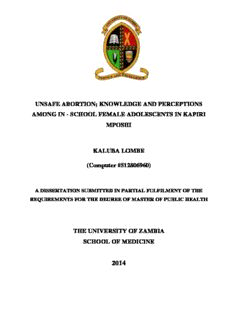
UNSAFE ABORTION PDF
Preview UNSAFE ABORTION
UNSAFE ABORTION; KNOWLEDGE AND PERCEPTIONS AMONG IN - SCHOOL FEMALE ADOLESCENTS IN KAPIRI MPOSHI KALUBA LOMBE (Computer #512806960) A DISSERTATION SUBMITTED IN PARTIAL FULFILMENT OF THE REQUIREMENTS FOR THE DEGREE OF MASTER OF PUBLIC HEALTH THE UNIVERSITY OF ZAMBIA SCHOOL OF MEDICINE 2014 ABSTRACT This study aimed to investigate unsafe abortion, which is more prevalent in most third world countries and contributes significantly to maternal morbidity and mortality. Majority of patients treated for induced abortion are adolescents, yet their knowledge and perceptions on unsafe abortion are understudied. A cross sectional descriptive and explorative study with a mixed method approach was carried out among school girls aged 15 to 19 years in Kapiri Mposhi , Central province of Zambia. The study aimed to assess schoolgirls’ knowledge on unsafe abortion and also their perceptions on induced abortion. A sample of 340 schoolgirls was subjected to a pre-tested self-administered questionnaire that captured data on knowledge on unsafe abortion and perceptions on induced abortion. For triangulation purposes, 16 schoolgirls were purposively selected to participate in two sessions of focus group discussions. Pearsons’ chi-square test was used to determine association between independent and dependent variables. Nvivo version 10 was used to assist the researcher in sorting and organising the qualitative data. Mean age of respondents was 16.6 years and at the time of the study 35% of the respondents had experienced their sexual debut. Out of these, 36.1% had ever been pregnant. Less than half (41.9%) of the adolescents that had been pregnant before reported having aborted. All the abortions were induced using methods that were ineffective and unsafe. The majority of respondents (92%) had negative perceptions towards abortion and 50.6% of the respondents had good knowledge on unsafe abortion. Factors associated with perceptions on abortion were age (P value>0.00) and ever had sex (p- value 0.02). Knowledge on unsafe abortion was associated with age (p-value 0.00), ever had sex (p- value 0.04) and ever used family planning (p-value 0.02). Qualitative findings showed that majority of the participants did not support abortion based on moral grounds. In order to increase adolescent girls’ knowledge on unsafe abortion and its related consequences, there is need for comprehensive sexuality and reproductive health education focusing on dangers of early pregnancy, unsafe abortion. Youth friendly medical services attending to their reproductive health needs should be made available, affordable and accessible. i DECLARATION I Kaluba Lombe, declare that this dissertation is my own original work and that it has not been submitted and will not be presented to any other university for a similar or any other degree award. Signature…………………………… Date……………………………… ii COPYRIGHT ©2014 All rights reserved. No part of this dissertation may be produced or transmitted in any manner without permission in writing from the researcher or the University of Zambia. iii DEDICATION To God who is my strength To my mother Matilda Kasumpa Lombe, my siblings Kabaso, Kateule, Lombe, Sampa and Chileshe. Lastly I dedicate this dissertation to the living memory of my late father Emmanuel Chota Lombe, iv CERTIFICATE OF COMPLETION OF DISSERTATION The undersigned certify that they have read this dissertation and are satisfied that this is the original work of the author under whose name it is being presented. …...…………………………… …………………………………. Dr. Rosemary Likwa Mrs Doreen Sitali (Principal Supervisor) (Co- Supervisor) Head of department: .............................................. Date: ............................................. Department: ............................................. v CERITIFCATE OF APPROVAL The University of Zambia approves this dissertation of Kaluba Lombe in partial fulfilment of the requirements for the award of the degree in Master of Public Health – Health Promotion. Examiners’ signatures Date Examiner 1 ............................................. ................... Examiner 2 ............................................. ................... Examiner 3 ............................................... .................... vi ACKNOWLEDGEMENTS This research would not have been possible without the help of several people who in one way or another played a great role. First and foremost I wish to thank the Ministry of Community Development Mother and Child Health for sponsoring my research Special thanks also go to my supervisors Dr Rosemary Likwa and Mrs Doreen Sitali for their invaluable feedback, mentoring and support. The Ministry of Education for allowing me to carry out the research in Kapiri Mposhi. I also wish to thank Dr. Charles Mwinuna and the entire Kapiri Mposhi District Health Management team for their moral support during the research. My mother for being a role model and raising me into a strong woman. May The Almighty God bless you all. vii TABLE OF CONTENTS ABSTRACT.………………………………………………………………………………..i DECLARATION……………………………………………………………………………ii COPYRIGHT………………………………………………………………………………..iii DEDICATION ……………………………………………………………………………...iv CERTIFICATE OF COMPLETION ……………………………………………………….v CERTIFICATE OF APPROVAL …………………………………………………………..vi ACKNOWLEDGMENTS …………………………………………………………………..vii List of Abbreviations ……………………………………………………………………….x Operational Definitions………………………………………………………………………xi List of Tables ………………………………………………………………………………xii List of Figures………………………………………………………………………………xiii List of Annexes …………………………………………………………………………… xiii CHAPTER ONE - INTRODUCTION 1.1 Background ………………………………………….......................................................14 1.2 Problem Statement ………………………………………................................................15 1.3 Rationale. .…………………………………………….....................................................16 1.4 Significance …………………………………………......................................................17 1.5 Objectives ………………………………………….........................................................17 CHAPTER TWO - LITERATURE REVIEW 2.1 Reasons why a pregnancy may be unwanted among adolescents....................................18 2.2 Consequences of Unsafe Abortion...................................................................................18 2.3 Review of Previous Studies on Adolescents and Unsafe Abortion .................................19 CHAPTER THREE - METHODOLOGY 3.1 Study Setting ……………………………………………................................................23 3.2 Study Population ………………………………………..................................................24 3.3 Study Design …………………………………………………........................................24 3.4 Variables ……………………………………………………..........................................24 viii 3.5 Sample Size Estimation ……………………………………….......................................25 3.6 Sampling Procedure ………………………………………….........................................26 3.7 Data Collection Tools ………………………………………..........................................26 3.8 Inclusion Criteria …………………………………………….........................................26 3.9 Exclusion Criteria ……………………………………………........................................26 3.10. Procedure for Data Collection ……………………......................................................27 3.11. Pre-testing …………………………………………….................................................27 3.12. Data Analysis …………………………………………................................................28 3.13 Disposal Plan …………………………………………….............................................28 3.14 Ethical Considerations ……………………………………...........................................28 CHAPTER FOUR - RESULTS 4.1 Quantitative Data…………………………………………..............................................30 4.3 Qualitative Data…………………………………………................................................42 CHAPTER FIVE - DISCUSSION 5.1 Discussion of Study Findings .........................................................................................46 5.2 Limitations ……………………………………………..................................................48 CHAPTER SIX – CONCLUSIONS AND RECCOMENDATIONS 6.1 Conclusions ……………………………………………..................................................49 5.5 Recommendations ……………………………………....................................................49 Bibliography…………………………………………………………...................................51 ix
Description: